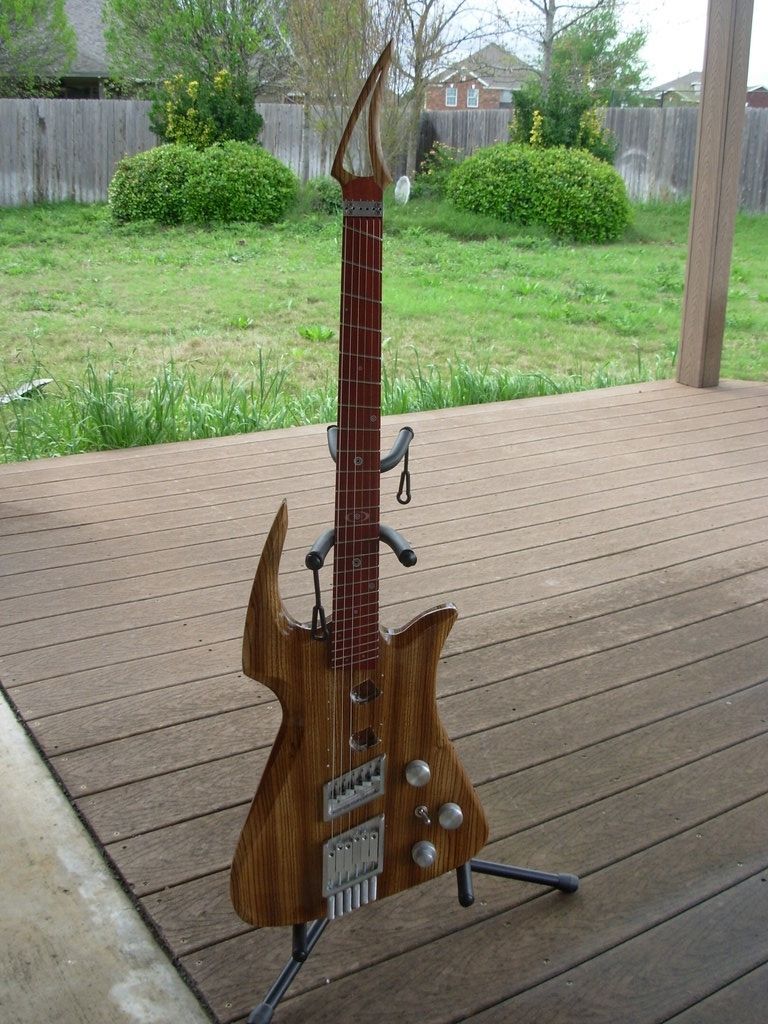Hi all, I wanted some low impedance pickups to go with the prototype guitar I recently finished, but I am having a heck of a time getting them to work. Here are some vital specs for what I am trying to accomplish:
- 1/8" thick aluminum frame
- CSE187 transformer (also have a cheapo 2000:1 transformer from the bay)
- Ceramic bar magnet pulled from cheapo strat pickup (just to try the idea out)
- 470k burden resistor from output signal to output ground to mimic a 500k volume pot
I have tried wiring the transformer up with the frame on either side of the transformer, with and without the load resistor. I have tried both transformers that I have, I have tried using neodymium disc magnets instead of the ceramic, orienting each of the four long faces of the magnet "up", all to no avail. Here is a picture of one of the arrangements I tried. I used brass strip to connect the transformer to the coil in an attempt to avoid the higher resistance of lead wire. To test, I have held the arrangement over the strings of one of my guitars and strummed with the pickup plugged in to a clean amp. I'm at my wits' end, as this doesn't seem like it should be too difficult. What am I missing?

- 1/8" thick aluminum frame
- CSE187 transformer (also have a cheapo 2000:1 transformer from the bay)
- Ceramic bar magnet pulled from cheapo strat pickup (just to try the idea out)
- 470k burden resistor from output signal to output ground to mimic a 500k volume pot
I have tried wiring the transformer up with the frame on either side of the transformer, with and without the load resistor. I have tried both transformers that I have, I have tried using neodymium disc magnets instead of the ceramic, orienting each of the four long faces of the magnet "up", all to no avail. Here is a picture of one of the arrangements I tried. I used brass strip to connect the transformer to the coil in an attempt to avoid the higher resistance of lead wire. To test, I have held the arrangement over the strings of one of my guitars and strummed with the pickup plugged in to a clean amp. I'm at my wits' end, as this doesn't seem like it should be too difficult. What am I missing?

 . I can tuck a copper loop under the aluminum and wire the copper wire directly to the transformer, that shouldn't be an issue. I just like the aluminum for the look. I will likely go ceramic on the finished product. I have a couple DL-CT1005A transformers, that are 2000:1 that I also tried without any audible output from my amp set at normal bedroom playing levels. I will look into mic matching transformers so I can plug straight into an amp. I would probably go copper plate instead of wire if it wasn't expensive (this guitar has run my spending money completely out).
. I can tuck a copper loop under the aluminum and wire the copper wire directly to the transformer, that shouldn't be an issue. I just like the aluminum for the look. I will likely go ceramic on the finished product. I have a couple DL-CT1005A transformers, that are 2000:1 that I also tried without any audible output from my amp set at normal bedroom playing levels. I will look into mic matching transformers so I can plug straight into an amp. I would probably go copper plate instead of wire if it wasn't expensive (this guitar has run my spending money completely out).
Comment